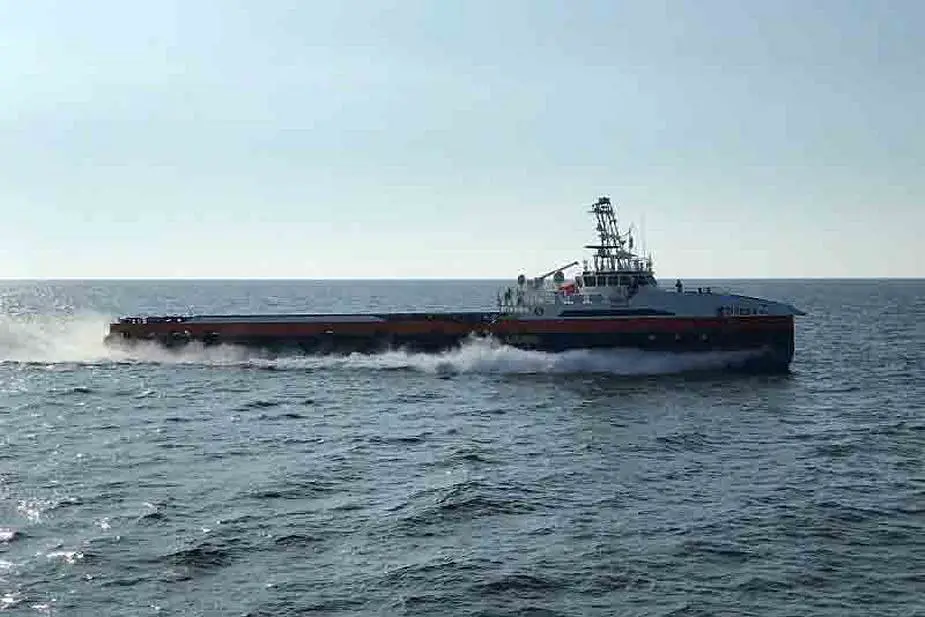According to information published by the United States Department of Defense (DoD) on January 13, 2021, A Ghost Fleet Overlord unmanned surface vessel, part of a partnership between the Defense Department's Strategic Capabilities Office and the Navy, recently traveled a distance of more than 4,700 nautical miles, almost entirely autonomously. Afterward, it participated in exercise Dawn Blitz where it again spent nearly all of its underway time operating autonomously.
Follow Navy Recognition on Google News at this link
 The unmanned surface vessel, part of the Strategic Capabilities Office's Ghost Fleet Overlord program of the U.S. Navy. (Picture source U.S. DoD)
The unmanned surface vessel, part of the Strategic Capabilities Office's Ghost Fleet Overlord program of the U.S. Navy. (Picture source U.S. DoD)
Operation Dawn Blitz is an annual military exercise orchestrated by the United States Navy and United States Marine Corps to simulate an amphibious assault by landing infantry and support on a beachhead. In recent years it has grown to incorporate the military of several US allies
The Ghost Fleet Overlord program is part of an effort to accelerate the Navy's push to incorporate autonomous vessels within its fleet to better expand the reach of manned vessels. Autonomy includes more than just straight-line passage through large areas of the ocean; it also involves such things as collision avoidance and following the rules of the sea.
The Navy's efforts to adopt the unmanned vessel concept involve several classes of ships and an array of missions, such as offensive operations and intelligence, surveillance and reconnaissance with reduced risk to crew and legacy vessels. The Ghost Fleet Overlord program has demonstrated continued maturity in the autonomous USV concept since it stood up in late 2018.
The most recent display of that maturity involved a USV traveling from the Gulf Coast to the coast of California, moving autonomously approximately 97% of the time. While the USV did have a crew on board, remote mission command and control for the trip was done from a remote location by sailors with Surface Development Squadron One.
One of the few times the USV was guided by its onboard crew was when it traversed the Panama Canal.
Optionally manned vessels provide a stepping stone to allow the Navy and its sailors to more easily become familiar with the concept of autonomous operations than what would be possible with a fully autonomous ship.
After arriving on the West Coast of the U.S., the Ghost Fleet Overlord USV participated in December's Dawn Blitz exercise with the Navy and Marine Corps. There, it successfully demonstrated compliance with international regulations for preventing collisions at sea, station keeping, loiter and transit missions. It was the first time a Ghost Fleet Overlord USV interacted with actual assets in the Navy fleet.
During its participation in Dawn Blitz, the Ghost Fleet Overlord USV operated autonomously for more than 130 hours and traversed roughly 950 nautical miles — accounting for approximately 98% of its underway time.
According to a U.S. Congress Report published on December 23, 2020, the U.S. Navy in Fiscal Year (FY) 2021 and beyond wants to develop and procure three types of large unmanned vehicles (UVs). These large UVs are called Large Unmanned Surface Vehicles (LUSVs), Medium Unmanned Surface Vehicles (MUSVs), and Extra-Large Unmanned Undersea Vehicles (XLUUVs). The U.S. Navy is requesting $579.9 million in FY2021 research and development funding for these large UVs and their enabling technologies.
The LUSV and MUSV programs are building on USV development work done by the Strategic Capabilities Office (SCO) within the Office of the Secretary of Defense (OSD). SCO’s effort to develop USVs (Unmanned Surface Vessel) is called Ghost Fleet, and its LUSV development effort within Ghost Fleet is called Overlord.
The US. Navy envisions LUSVs as being 200 feet to 300 feet in length and having full-load displacements of 1,000 tons to 2,000 tons, which would make them the size of a corvette. The U.S. Navy defines MUSVs as being 45 feet to 190 feet long, with displacements of roughly 500 tons. The Navy wants MUSVs, like LUSVs, to be low-cost, high-endurance, reconfigurable ships that can accommodate various payloads. Initial payloads for MUSVs are to be intelligence, surveillance, and reconnaissance (ISR) payloads and electronic warfare (EW) systems.



